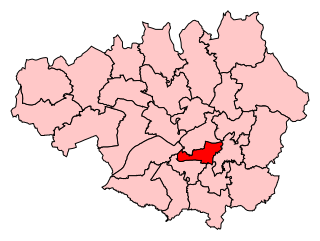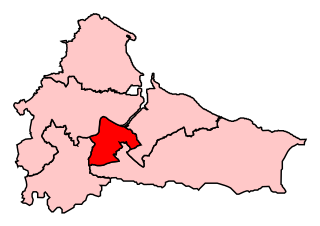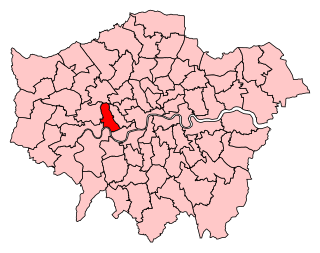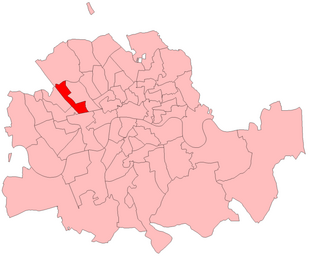
Ashford is a constituency created in 1885 represented in the House of Commons of the UK Parliament since 1997 by Damian Green, a Conservative, who served as First Secretary of State between 11 June and 20 December 2017.

Manchester Gorton is a constituency represented in the House of Commons of the UK Parliament by Labour's Afzal Khan, who was elected at the 2017 general election. It is the safest Labour seat in Greater Manchester by numerical majority and one of the safest in the country.

Middlesbrough is a parliamentary constituency in the United Kingdom, recreated in 1974, and represented since 2012 in the House of Commons of the UK Parliament by Andy McDonald from the Labour Party. An earlier version of the seat existed between 1868 and 1918.

Ludlow is a constituency represented in the House of Commons of the UK Parliament since 2005 by Philip Dunne, a Conservative.

Fareham is a constituency represented in the House of Commons of the UK Parliament. Since 2015, it has been represented by Suella Braverman of the Conservative Party. She is currently the Attorney General.

Hammersmith is a parliamentary constituency in the House of Commons of the UK Parliament. It is currently represented by Andy Slaughter, a member of the Labour Party, who has represented the seat since its recreation in 2010.

Mid Derbyshire is a constituency represented in the House of Commons of the UK Parliament since its 2010 creation by Pauline Latham, a Conservative.

North Somerset is a constituency represented in the House of Commons of the UK Parliament since 2010 by Liam Fox, a Conservative who served as Secretary of State for International Trade, a new position in the Cabinet, from 2016 to 2019.
Birmingham Central is a former parliamentary constituency in the city of Birmingham, England. It returned one Member of Parliament (MP) to the House of Commons of the Parliament of the United Kingdom, elected by the first-past-the-post voting system.
Birmingham East was a parliamentary constituency in the city of Birmingham, England. It returned one Member of Parliament (MP) to the House of Commons of the Parliament of the United Kingdom, elected by the first-past-the-post voting system.
Birmingham North was a parliamentary constituency in the city of Birmingham, England. It returned one Member of Parliament (MP) to the House of Commons of the Parliament of the United Kingdom, elected by the first-past-the-post voting system.

Peckham was a borough constituency in South London which returned one Member of Parliament (MP) to the House of Commons of the Parliament of the United Kingdom. Elections were held using the first-past-the-post voting system.
Birkenhead West was a parliamentary constituency that returned one Member of Parliament (MP) to the House of Commons of the Parliament of the United Kingdom, elected by the first past the post voting system.
Birmingham South was a parliamentary constituency in Birmingham which returned one Member of Parliament (MP) to the House of Commons of the Parliament of the United Kingdom from 1885 until it was abolished for the 1918 general election.
Birmingham Handsworth was a parliamentary constituency centred on the Handsworth district of Birmingham. It returned one Member of Parliament (MP) to the House of Commons of the Parliament of the United Kingdom. It was abolished in 1983.

Plaistow was a borough constituency returning a single Member of Parliament to the House of Commons of the Parliament of the United Kingdom through the first-past-the-post voting system. The constituency was one of four divisions of the Parliamentary Borough of West Ham, which had at the time the same boundaries as the County Borough of West Ham. Although administratively separate since 1889, the area was formally part of the county of Essex; since 1965 it has been part of the London Borough of Newham in Greater London.
West Ham South was a parliamentary constituency in the County Borough of West Ham, in what was then Essex but is now Greater London. It returned one Member of Parliament (MP) to the House of Commons of the Parliament of the United Kingdom, elected by the first-past-the-post voting system.
Birmingham Bordesley was a borough constituency in the city of Birmingham, which returned one Member of Parliament (MP) to the House of Commons of the Parliament of the United Kingdom. Elections were held using the first-past-the-post voting system.
Richmond (1918–1983) was a parliamentary constituency centred on the town of Richmond. The seat mirrored for its first 47 years a small northern projection of Surrey. For the final 18 years its area, in local government, fell into the new county of Greater London.

Marylebone West was a borough constituency located in the Metropolitan Borough of St Marylebone, in London. It returned one Member of Parliament (MP) to the House of Commons of the Parliament of the United Kingdom, elected by the first past the post voting system.











